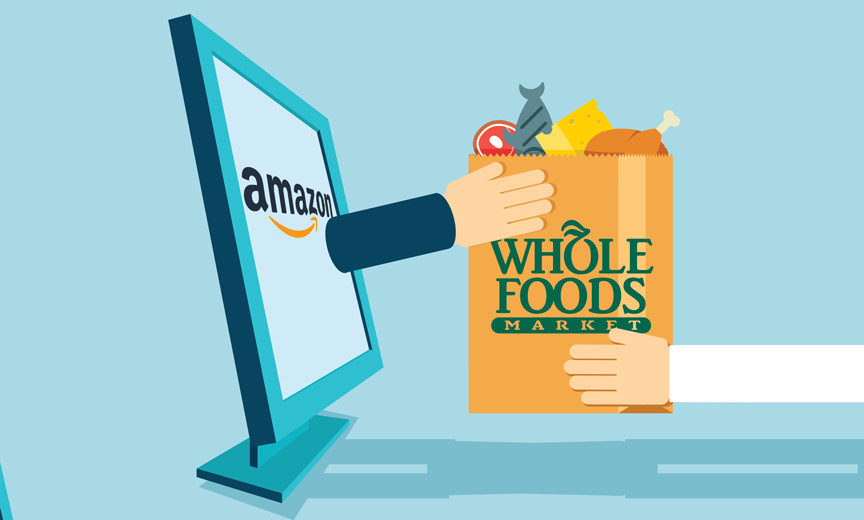At 16 years old, I saw Sandra Bullock ordering pizza online in The Net and it became my teenage obsession. At the time, that scene embodied my boyhood fantasy of an ultra-connected tech future. It was the mid-’90s, grunge was everywhere and dial-up services like AOL billed by the minute. Looking back, I now realize that Bullock’s character was less living the luxe life and more wallowing in isolation as she hacked together a customized pie for delivery from the fictitious Pizza.net.
Fast forward 25 years and that vision of the future has more than come to pass. There’s almost no Avoiding the Noid when all you need to do is tweet a pizza emoji to alert Domino’s of a delivery desire. Plus – unlike the very limited reach of a 54-hundred baud modem circa 1995 – today’s high-speed access gives the term “fast food” a whole new meaning.
But it’s not just fast food that has been brought so tantalizingly close at hand by touch screens and track pads and smart phones (oh my!).
Behemoths Rising
It was close to the same time during the nascent dot-com boom of the 1990s when both Amazon.com and Whole Foods Market began their respective journeys toward offering the ultimate in choice, quality and speed of satiation. Jeff Bezos founded Amazon.com in 1994. A few years later in 1997, one of the many consolidated subsidiaries that came to make up present day Whole Foods – WholePeople.com – began to seriously explore the online sales potential of their products.
Those visions of the future lead to this present day singularity: The tools of our present full of instant gratification were already in place. However, it would take more than a dozen years for Amazon to become profitable, and about the same for Whole Foods to establish itself as a premium grocer throughout major markets of the nation. Another decade passed, and now these two behemoths of business have finally merged into a super massive black hole of perpetual indulgence.
Read Next | NYC Bath Houses Are Back, and Gay Men Are Cruising Them Once More
Instantly Gratified?
In theory, Amazon’s logistical ingenuity combined with Whole Foods’ curated grocery acumen means that consumers can now declare that “fast” food is no longer synonymous with groceries considered subpar.
Or can we? In researching this article, I must admit I was at first confused and ultimately, pretty far from instantly gratified by the reality of Amazon Prime Now delivery through Whole Foods.
That’s not to say what’s available isn’t good. It might even be great. However, the sheer volume of choices can be a barrier to entry compared to the simple user experience once anticipated by the fictional pizza configurator depicted in The Net. Though we long ago grew accustomed to such services from the likes of Domino’s and Pizza Hut, the ultimate result is just faster fast food. However, the partnering of Amazon and Whole Foods does actually result in several crossover services you need to understand in order to get the most in return. However once you do, they can yield high quality food, much faster.
More From Metrosource[wpp range=”last20days” cat=’22,26,16259,19687′ thumbnail_width=75 thumbnail_height=50 limit=3 stats_views=0]
The Mega-Merger Menu
To make the most of these services, you need to grasp the various ingredients making up the recipe. It begins at Amazon and it ends with Whole Foods at your door. In between is Prime, a $119 annual (or $12.99 monthly) subscription that includes Amazon Prime Now two-hour delivery. Use it to find most of your Whole Foods favorites — including their prepared meals and 365 branded products.
Meanwhile, Amazon Fresh is a total grocery delivery add-on to your Prime subscription that ups your monthly cost by another $14.99. Amazon Fresh combines Whole Foods offerings with more conventional supermarket brands. (However this, as well as Prime membership, is provided free of charge for customers with a valid SNAP/ EBT card.) In most major markets, orders over $35 are delivered at no extra charge. Elsewhere, that threshold is $50. But let’s say you absolutely require a pack of gum delivered. You can have it for the price of the gum and a $9.99 fee. You can further request a one hour “attended delivery” window that arrives in paper bags. Or you can request a 2-3 hour “doorstep delivery” in temperature-controlled totes – depending on location and availability.
Whole Foods Discounts for Amazon Prime Members can be obtained both in-store and when ordering online. You can even front-load your shopping trip by checking out the available discounts online first. But remember: Get that app installed before you get to the checkout in order to authenticate your membership.
Read Next | NYC Bath Houses Are Back, and Gay Men Are Cruising Them Once More
Special Deliveries
If you’re prepared to make the internet your cyber-sous chef, Amazon and Whole Foods can up your kitchen game to gourmet levels. But it’ll take thought, planning and coordination. Ultimately, it’s less about gratifying your every whim of instant consumption and more like employing a robotic workforce to keep supplies coming aligned with your culinary forecast. If you use these services at peak efficiency, they can provide a route to a healthier lifestyle and more efficient food budgeting. Or – if you simply enjoy the thrill of ordering groceries online as easily as Sandra ordered pizza in The Net — they might be just one more indulgence.
Want Metrosource LGBTQ content notifications? Sign up for MetroEspresso.

Read Next | Finding an Outstanding LGBT-Friendly Lawyer in New York
Last modified: October 28, 2019














